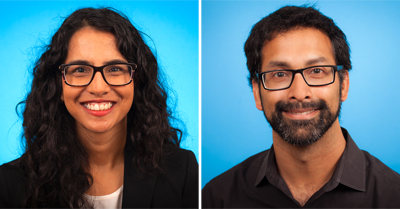Patients not uncomfortable disclosing race and ethnicity on clinic forms but questionnaires can lack clarity, appropriate options: St. Michael’s Hospital study

By Anna Wassermann

Drs. Tara Kiran and Andrew Pinto
Patients who filled out a sociodemographic data questionnaire before seeing a doctor were comfortable answering questions about their race and ethnicity, but some struggled to identify with the options on the form, suggests a study led by scientists at St. Michael’s Hospital’s MAP Centre for Urban Health Solutions, and recently published in Canadian Family Physician.
The study focused on patients at five of St. Michael’s Family Health Team clinic sites, which have been collecting sociodemographic data since 2013 as a way to understand who they’re serving and address potential inequities in care. Despite high response rates over the last six years, it’s been unclear how patients react to the collection of race and ethnicity data.
“In Canada, we know that people from different racial and ethnic backgrounds experience care differently and sometimes have different health outcomes,” said Dr. Tara Kiran, co-author and associate scientist at the MAP Centre for Urban Health Solutions in the Li Ka Shing Knowledge Institute.
“Collecting accurate data on race and ethnicity is a first step to understanding and reducing these disparities. But collecting the data can be tricky. On the one hand, we want to document disparities to reduce them, but on the other hand, we don’t want patients to feel uncomfortable, or for their responses to lead to further stigmatization or discrimination.”
To explore patients’ comfort levels and thought processes when responding to questions about race and ethnicity, the research team conducted interviews with patients who had recently completed a sociodemographic questionnaire after registering for their medical appointment.
The questionnaire included one question about patients’ race and ethnicity and respondents were asked to select the option they most closely identified with.
In the interviews, patients were asked whether responding to the question about race and ethnicity was difficult or uncomfortable, how they interpreted race and ethnicity, and what response options they considered.
The team found that patients were not uncomfortable responding to the question but they had different interpretations about what was being asked. Most patients thought race and ethnicity pertained to their heritage, culture, or parents’ background. Others thought it related to one’s own place of birth and upbringing.
Among all respondents, patients of mixed heritage had the most difficulty interpreting and answering the question, said Dr. Andrew Pinto, co-author and scientist at the Li Ka Shing Knowledge Institute.
“Some respondents described picking their own place of birth or upbringing, while others described where their parents came from,” Dr. Pinto said.
Even in the few cases in which patients of mixed heritage felt confident in their interpretation of the question, they often found it difficult to select an option from the list provided.
With these results in mind, Drs. Kiran and Pinto suggest that future research is needed to gather recommendations from patients in primary care organizations across Canada on how to best explain the purpose of race and ethnicity data collection. In addition, patients should be asked about optimal wording to explain the definition of race and ethnicity and related response options
“Part of the reason we conducted this study was to prompt a discussion about whether it’s time to update the questionnaires we’re using to collect race and ethnicity data,” said Dr. Kiran.
Furthering this work, Dr. Pinto is leading a project funded by CIHR to collect patient sociodemographic data and address related issues in primary care settings across Saskatchewan, Manitoba, Ontario, Nova Scotia and Newfoundland and Labrador.
“There are a number of people who feel strongly that we should be collecting sociodemographic data provincially, but we need to ensure that questionnaires are user friendly and informed by patients’ lived experience,” said Dr. Pinto.
This paper is an example of how St. Michael’s Hospital is making Ontario Healthier, Wealthier, Smarter.
About St. Michael’s Hospital
St. Michael’s Hospital provides compassionate care to all who enter its doors. The hospital also provides outstanding medical education to future health care professionals in more than 27 academic disciplines. Critical care and trauma, heart disease, neurosurgery, diabetes, cancer care, care of the homeless and global health are among the Hospital’s recognized areas of expertise. Through the Keenan Research Centre and the Li Ka Shing International Healthcare Education Centre, which make up the Li Ka Shing Knowledge Institute, research and education at St. Michael’s Hospital are recognized and make an impact around the world. Founded in 1892, the hospital is fully affiliated with the University of Toronto.
About Unity Health Toronto
Unity Health Toronto, comprised of Providence Healthcare, St. Joseph’s Health Centre and St. Michael’s Hospital, works to advance the health of everyone in our urban communities and beyond. Our health network serves patients, residents and clients across the full spectrum of care, spanning primary care, secondary community care, tertiary and quaternary care services to post-acute through rehabilitation, palliative care and long-term care, while investing in world-class research and education. For more information, visit www.unityhealth.to.
